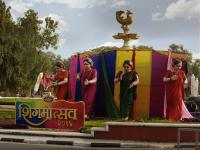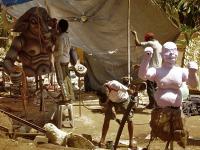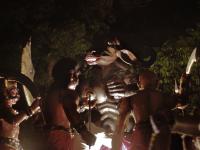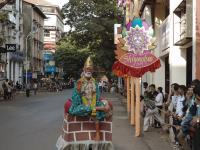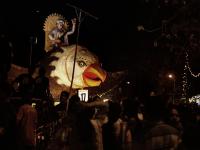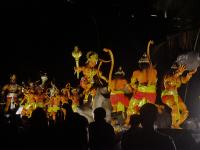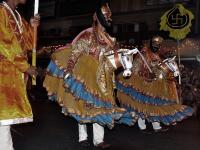Shigmotsav in Goa
Every season in India is welcomed by a special festival in order to express gratitude and to foster the feelings, of love for nature. ‘Shigmotsav’ is one of them which is popularly known as Shigmo. In Goa, Shigmotsav is celebrated by common people. Bidding adieu to the winters, Shigmotsav is celebrated on a full moon day during the month of March (Falgun), which is also the last month of the Hindu calendar. It is usually celebrated fourteen days before the festival of colours, Holi.
The Hindu Goan ethnicity begins the celebration with a collective prayer and naman, where they kneel together making a vow, shunning intoxicants and non-vegetarian food – from the ninth moon day up to the full moon day.
On the eleventh Moon day until the fifteenth moon day villagers assemble in their multi-coloured attires setting the mood for festivity with column-like red spotted flags – ‘Dhwaja’, beating the drums and playing flutes together at the village temples, and performing dances within the temple courtyards while singing various folk songs. The celebration starts in the afternoon and goes on until the moon shines high in the sky.
In Goa, Shigmotsav is celebrated across 5 days, with the gaiety of one-day carnivals that takes place on the main road of Goa, Panjim, Mapusa, Vasco & Margao on each day; they become an eye pleasing treat for tourists travelling during these months.
https://www.google.co.in/search?q=Shigmotsav+Goa&tbm=isch&tbo=u&source=univ&sa=X&ei=V1GuU83mD9OcugT6yIKQBQ&ved=0CBoQsAQ
http://www.goaholidayhomes.com/information/shigmo-festival-in-goa.html
http://www.goatourism.gov.in/events/details/115/318
https://www.facebook.com/pages/Shigmotsav-GOA/318509979323
https://www.youtube.com/watch?v=L7simgei1rc
http://en.wikipedia.org/wiki/Shigmo

Artists creating a puppet of ten headed Ravana.
It is a festive and colourful occasion for which thousands of devotees take part. They create puppets of the characters from the Hindu mythology to participate in the Shigmo parade. According to the Hindu mythology, Goa is also known as the land of the Gods and with good reasons. There are hundreds of Gods and Goddesses with differing traditions, rituals and names, adored in Goa. Most of these have remained unchanged over the centuries while others have evolved with the circumstances and changing times.

The artists engaged in detailing the puppet for the parade of Shigmo.
The creation of the floats and the puppets to participate in the parade begin much earlier. Artists put all their skills and ideations in the detailing of the characters exactly as mentioned in the Hindu mythology. The artists work hard to make it look attractive even by maintaining the real look and feel of the character. Use of plaster of Paris and polystyrene makes it light in weight that eases the movement of mobile puppets.

This is one of the participants dressed up like the Lord Hanuman from the Indian mythology in Shigmotsav procession.
Traditional folk dances, brightly dressed street-dancers, float depiction mythological events, music instruments, headgear, masks form part of the exciting parade. People get immersed in this festival and celebrate the colourful Shigmotsav.

Folk dances are performed to the heavy bets of the Dhol and Tasha (Huge Drums) Dressed up in the traditional costumes; various folk groups consisting of women and men dancers give vibrant performances of various dances. These are interspersed with the groups that move along the route with their traditional Goan drums.

The float is carrying the death god Yama with his followers. The biggest attraction of Shigmotsav is to enjoy the procession of highly creative floats, decorated with different characters from Hindu Mythology. These mobile puppets are carried in trucks around the town till mid of the night and one float carries minimum twenty-five people. People from all over the world come to Goa to see this festival.
